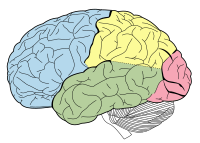
Photo from wikipedia
Background and Objectives To determine the association between surgical lesions of distinct gray and white structures and connections with favorable postoperative seizure outcomes. Methods Patients with drug-resistant temporal lobe epilepsy… Click to show full abstract
Background and Objectives To determine the association between surgical lesions of distinct gray and white structures and connections with favorable postoperative seizure outcomes. Methods Patients with drug-resistant temporal lobe epilepsy (TLE) from 3 epilepsy centers were included. We employed a voxel-based and connectome-based mapping approach to determine the association between favorable outcomes and surgery-induced temporal lesions. Analyses were conducted controlling for multiple confounders, including total surgical resection/ablation volume, hippocampal volumes, side of surgery, and site where the patient was treated. Results The cohort included 113 patients with TLE (54 women; 86 right-handed; mean age at seizure onset 16.5 years [SD 11.9]; 54.9% left) who were 61.1% free of disabling seizures (Engel Class 1) at follow-up. Postoperative seizure freedom in TLE was associated with (1) surgical lesions that targeted the hippocampus as well as the amygdala–piriform cortex complex and entorhinal cortices; (2) disconnection of temporal, frontal, and limbic regions through loss of white matter tracts within the uncinate fasciculus, anterior commissure, and fornix; and (3) functional disconnection of the frontal (superior and middle frontal gyri, orbitofrontal region) and temporal (superior and middle pole) lobes. Discussion Better postoperative seizure freedom is associated with surgical lesions of specific structures and connections throughout the temporal lobes. These findings shed light on the key components of epileptogenic networks in TLE and constitute a promising source of new evidence for future improvements in surgical interventions. Classification of Evidence This study provides Class II evidence that for patients with TLE, postoperative seizure freedom is associated with surgical lesions of specific temporal lobe structures and connections.
Journal Title: Neurology
Year Published: 2022
Link to full text (if available)
Share on Social Media: Sign Up to like & get
recommendations!